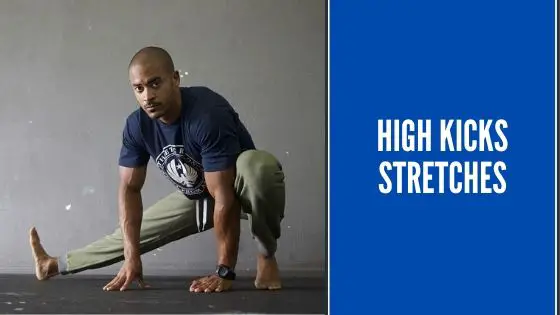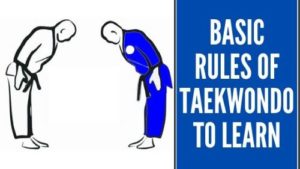Performing high kicks stretches is very important. Some will say that it is not necessary, but this depends entirely on each body, a very important recommendation is to stretch well and as much as possible.
Stretching correctly and preparing our body with an adequate special stretching for high kicks, not only helps to execute the kicks but also to make our body more flexible to move and not to hurt itself so much, giving flexibility to the body in front of sudden changes.
Do you want to open your legs like Jean Claude Van Damme? Then, static and sustained stretching is a good idea for you. If instead, you want to do high kicks just like the martial artists doing cool stunts on social media, then a combination of static, dynamic and ballistic stretching is ideal.
Before going deeper into the subject, it is important to remind you that you should not do any stretching without first warming up for at least 10 minutes before starting your routine.
Dynamic flexibility is how far you can go, bend or turn without external help. That is, how far you can go, bend or reach using only voluntary contraction and relaxation of your body muscles.
On the other hand, ballistic flexibility is the same voluntary reach manifested through explosive movements. Kicks, especially high kicks, are considered ballistic moves. Therefore, to achieve our goal of delivering a high kick, it is essential to develop ballistic flexibility.
Dynamic stretches are slow and controlled movements. Ballistic stretches, conversely, come from explosive action. They should be appropriate (or similar) to the activity you are going to perform, in this case, martial arts. Taekwondo is a martial art style that is focused on kicking.
The movements start slowly and gradually increase the amplitude and speed in each series.
Remember; perform the movements in a controlled manner along with the entire routine. Unlike ballistic stretches, in dynamic stretches, there are no sudden or bouncing movements.
Fatigue has been shown to reduce all types of flexibility; so if at any point you become fatigued during stretches, it is best to stop and rest.
Take a break and continue with your high kicks stretches.
1. High front kicks
These are a staple if you want to kick higher.
- Raise your right arm until it is straight in front of you, parallel to the floor.
- Stretch out your hand, palm facing the floor.
- Step forward to put your weight on your left foot and kick your right foot into your hand with your toes bent.
- Try to touch your palm with your toes.
- Repeat by alternating your legs.
- Once you feel comfortable, raise the height of your arms in the next sessions.
There are two ways in which you can try to kick your foot into your hand: by bringing your knee up, then your foot; or by bringing your whole leg from the ground without bending your knee. For the latter, which counts as a ballistic stretch, you will need to perform some basic hamstrings and adductors stretches first to avoid injuries. Performing both variations can really add to your experience doing high kicks stretches.
2. Backward kicks
These help to stretch the hamstrings and condition the glutes to the contraction and relaxation during front and sidekicks as well.
- Place a rigid chair in front of you. Take a step backward and lean forward over the chair.
- Start with your toes slightly apart.
- Put your right foot straight behind you, with your toes touching the floor.
- Kick as high as you can, while making sure your lower back is stable. Look straight ahead to keep your spine in line.
- Repeat, doing 20 to 30 high kicks.
- Switch legs. Your goal should be to stretch your leg back as far as you can while kicking.
- You should always kick moderately.
3. Knee Raises
It is said that most of the height a kick has come from the height and reach of the knee. This makes knee raises one of the best high kicks stretches you can perform.
- Extend your arms in front of you and keep your hands at waist level.
- Run in place as you raise your quads high enough to touch your hands with each step.
- Continue to alternate knees as many times as possible, for 30 to 60 seconds.
This exercise is also good for the trunk and for cardiovascular training. Repeat at high-intensity intervals.
4. Heels to Buttocks
This exercise aims to exercise your buttocks, which are important for increasing the flexibility and extension of your hips
- Run in place, without bringing your calves forward, and kick backward with each step.
- Bring your heels as high as you can with each step. You have to try to kick your buttocks with your heels.
- Run in place for 30 seconds.
The high kicks stretch described above can be performed both as ballistic and dynamic stretches, varying their intensity and reach. However, you should also aim to include static stretches in all your exercise routines. You should do basic stretches of your hamstrings, quadriceps, and hip flexors before attempting them. Be sure to warm up for at least 5 minutes with cardiovascular exercise.
5. Do a center split.
- Sit on the floor with your legs open and stretch them out completely. Put your hands in front of you, firmly, above your groin.
- Transfer your weight slowly into your arms.
- Rotate forward until you feel your groin stretch. Stop rotating if it hurts too much.
- Continue the stretch for 90 seconds to 3 minutes.
6. Do a side split.
- Sit with your right and left leg extended in opposite directions.
- Keep your left leg bent until you are ready to stretch.
- Put your arms on either side of your legs. Transfer the weight to your arms.
- Lift your body and try to bend your back knee to get out of the starting position.
- Your goal should be to keep both legs stretched out in opposite directions, with the weight concentrated on the center of your body.
- Try to keep the stretch in a position that is not painful for you.
- Continue for about 30 to 60 seconds. Switch sides.
Do this every day for maximum benefit.
7. Butterfly Stretch
This exercise exercises the adductors, a group of muscles on the inner thigh.
- Sitting on the floor, bend your knees and bring your feet together, keeping your soles together.
- Grasp your feet with both hands and direct them gently towards your thighs until you feel a slight tension in the inner thigh area.
- To exert more pressure, place your elbows on your knees and push your legs to the floor. It is important to keep your back straight.
- Hold the position for 30 seconds and rest. Perform the exercise 3 times.
Related: Martial Arts: Basic Taekwondo Kicks
It is extremely important that you combine, with your high kicks stretches, exercises that help strengthen your trunk and at the same time exercises that improve your balance, these will compliment your stretches and make your high kicks much more effective.
To achieve high kicks, regular practice will be the secret, strengthening your muscles and improving both your balance and your form. Learning to kick higher is not something you can do overnight, but if you commit to your workout and include these high kicks stretches, you will improve quickly and in less time.
httpv://www.youtube.com/watch?v=–SAbvaYuJY





